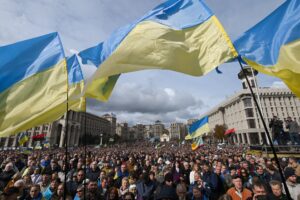Thirty years ago, in my economics textbook in India, the section on international trade referred to Argentina. It would be better, according to the textbook, for the country to concentrate on the production and export of beef, while Germany should direct its resources towards the production of electronics.
This example was used to illustrate Adam Smith’s “absolute advantage” principle – countries should focus on what they do “best,” rather than diversify their economies. It seemed churlish to me, that developing countries such as Argentina should only produce raw materials, while wealthy countries such as Germany went ahead with technological development.
Argentina, at that time, was still a major producer and exporter of beef. My peers and I had no access to José Hernández’s epic poem “Martín Fierro,” about the gauchos of the pampas, the cowboys of the plains of Argentina, but we knew of the ferocious compadritos (street-corner thugs) and cuchilleros (knife fighters) from the short stories of Jorge Luis Borges.
There were cowboys mixed in here, loners who sat on their horses on Argentina’s flatlands and gathered their cattle for the market. No longer do these horsemen define Argentina’s rural society. Today, the countryside is defined by the small farmer and the agricultural proletariat who work for the large agribusinesses and are the protagonists of the country’s fortunes.
In 2021, the World Trade Organisation (WTO) noted that Argentina remains “a major exporter of agricultural products,” which, at that time, accounted for nearly two-thirds of the country’s exports. As of April 2023, agricultural goods accounted for 56.4 percent of the country’s exports. The main products are grains — wheat, maize, soya — and beef.
Argentina’s agribusinesses enthusiastically entered into the global soybean market, even producing a “soy dollar” scheme to encourage greater exports so that the country could earn dollars to offset its major foreign exchange crises.
Argentina has been wracked by three consecutive years of drought (exacerbated by the climate catastrophe) and faced pressure from the increasing acreage for soybeans in the other four leading producers (Brazil, the United States, China and India).
The production of soybeans has transformed Argentina’s countryside, drawing in over half of the country’s arable lands and concentrating production into the hands of what the economist Claudio Scaletta called the “invisible giants” (corporations such as Cargill, Archer Daniels Midland Argentina, Bunge Argentina, Dreyfus, and Noble Argentina).
It is no longer cattle that run through the pampas; it is now the soybean flowers that tilt in the breeze.
Tricontinental‘s latest dossier, “Whose Land Is It and What Is It For? An Unfinished Debate about Land Access in Argentina” explores some of the most startling contradictions that afflict Argentina’s rural landscape. The most obvious incongruity is that Argentina has more than enough arable land to feed its 46 million people, and yet hunger is growing in the country.
Most of the food consumed by the people is produced not by the large agribusiness conglomerates but by family farms, and yet these family farms are disappearing as families find it impossible to economically sustain themselves and make the trek from rural areas to the cities in large numbers.
Rising landlessness and hunger have produced the social reality out of which new forms of political protest have appeared: verdurazos (vegetable protests) and panazos (bread protests), often led by rural social organisations, confront the ridiculous situation in which those who farm the soil cannot eat its crops.
A few years ago, I spent some time with small-scale farmers outside La Plata. Wildo Eizaguirre of the Federación Rural told me that the greatest burden for farmers such as himself is rent.
Antonio García as well as Else and Mable Yanaje agreed that rent is a dead weight for them. The cost of land is prohibitive and their tenure on the land is uncertain. It prevents the farmers from making capital improvements to the farm or even from buying equipment, such as tractors, to make their labour more productive.
These farmers neither own the fields nor do they control the pathways to the market. Brokers buy their produce at the lowest prices and then take them to be processed or sold directly to supermarkets. The money is made elsewhere than on the fields.
The land access bills proposed in Argentina in recent years are based on two key laws, the Historical Reparation of Family Agriculture Law (no. 27118, 2014) and the Indigenous Territories Emergency Law (no. 26160, 2006).
It is out of the struggles of people such as Wildo and Mable that Argentina’s government passed key laws such as the Historical Reparation of Family Agriculture Law of 2014 and the Indigenous Territories Emergency Law of 2006 (repeatedly extended in 2009, 2013, 2017, and 2021).
The Historical Reparation of Family Agriculture Law seeks to “construct a new rural life in Argentina” and guarantee “access to land for family, peasant, and indigenous agriculture, given that land is a social good.” These are powerful words but, in the face of the power of the agribusiness, they are not often translated into deeds.
The law itself does not close off the class struggle. In Brazil, for instance, the Movement of Rural Landless Workers (MST) uses the 1988 Brazilian Constitution to the letter as a legal justification for its land occupations.
And yet, punctually, Brazil’s agribusinesses and their political allies try to criminalise the MST occupations with a Parliamentary Commission of Inquiry, which MST leader João Paulo Rodrigues correctly considers an opportunity to hold a public dialogue about agrarian reform, food sovereignty and social equality.
Largest 1% of Farms Owns 80% of Farmland
In 2020, the International Land Coalition and Oxfam released an important report called “Uneven Ground. Land Inequality at the Heart of Unequal Societies.” There are 608 million farms in the world, the report notes, most of them being family farms (with 2.5 billion people involved in smallholder farming).
The largest 1 percent of the farms, however, control more than 70 percent of global farmland, while 80 percent of the farmers are smallholders who operate less than two hectares. Land concentration, the report shows, has increased dramatically since 1980.
Meanwhile, according to a study by Luis Bauluz, Yajna Govind, and Filip Novokmet, in Latin America the top 10 percent of landowners capture up to 75 percent of the agricultural land value, while the bottom 50 percent own less than 2 percent.
As the dossier highlights, in Argentina the disparity is extremely sharp: 80 percent of family farmers (who are characterised as smallholders) occupy around 11 percent of demarcated agricultural land, while the big landowners who make up 0.3 percent of farmers occupy almost double that land.
The tendency towards land concentration is hastened by the power of multinational agribusinesses and by the increasing use of farmland as a financial asset by private equity firms and asset managers (as Madeleine Fairbairn argues in her book Fields of Gold: Financing the Global Land Rush, 2020).
On the African continent, farmers are being pushed off the land due to “nature conservation” and the growth of the mining sector (such as documented in Xolobeni in South Africa).
Over the past century, peasant movements have put forward a demand for “agrarian reform” as the antidote to capitalism’s devastation of the countryside.
In the foreword to the dossier, Manuel Bertoldi of the Federación Rural writes, “We must start talking without fear about agrarian reform, food sovereignty, agroecology, and about socialism as an alternative system, since it is through socialism that these ideas become viable.”
The Brazilian poet João Cabral de Melo Neto wrote with great feeling about the only piece of land to which the peasants are entitled, their graves. In 1955, he composed the verse “Morte e Vida Severina (“Death and Life of Severino’”), where he wrote,
– The grave you’re in
Is measured by hand,
The best bargain you got
In all the land.
– You fit it well,
Not too long or deep,
The part of the latifundio
Which you will keep.
– The grave’s not too big,
Nor is it too wide,
It’s the land you wanted
To see them divide.
– It’s a big grave
For a body so spare,
But you’ll be more at ease
Than you ever were.
– You’re a skinny corpse
For such a big tomb,
But at least down there
You’ll have plenty of room.
Farmers and peasants around the world know that their struggles are existential, a feeling that gripped the Indian farmers and peasants during their ongoing struggle against the privatisation of the marketplace for agricultural commodities. They want land to live, not just for their graves.
Source : Consortium News











